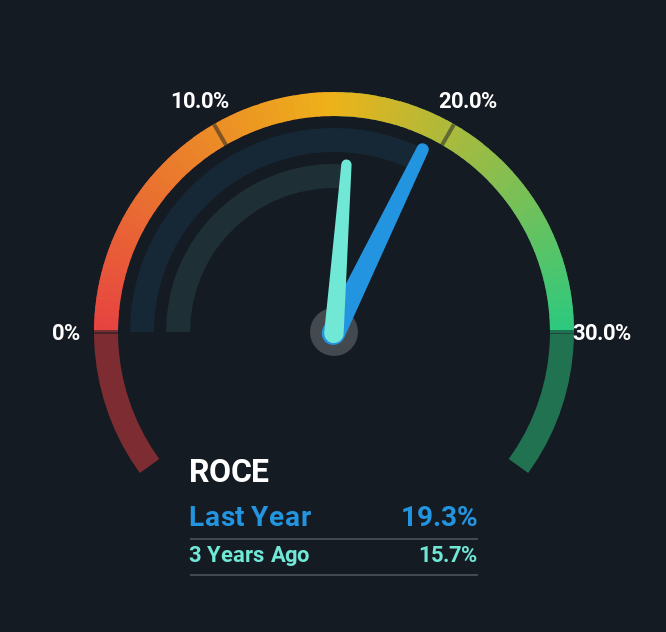What trends should we look for it we want to identify stocks that can multiply in value over the long term? Amongst other things, we'll want to see two things; firstly, a growing return on capital employed (ROCE) and secondly, an expansion in the company's amount of capital employed. If you see this, it typically means it's a company with a great business model and plenty of profitable reinvestment opportunities. With that in mind, we've noticed some promising trends at K Car (KRX:381970) so let's look a bit deeper.
Understanding Return On Capital Employed (ROCE)
For those that aren't sure what ROCE is, it measures the amount of pre-tax profits a company can generate from the capital employed in its business. Analysts use this formula to calculate it for K Car:
Return on Capital Employed = Earnings Before Interest and Tax (EBIT) ÷ (Total Assets - Current Liabilities)
0.19 = ₩72b ÷ (₩552b - ₩181b) (Based on the trailing twelve months to March 2025).
Therefore, K Car has an ROCE of 19%. On its own, that's a standard return, however it's much better than the 9.2% generated by the Specialty Retail industry.
Check out our latest analysis for K Car

Above you can see how the current ROCE for K Car compares to its prior returns on capital, but there's only so much you can tell from the past. If you're interested, you can view the analysts predictions in our free analyst report for K Car .
So How Is K Car's ROCE Trending?
K Car is displaying some positive trends. The numbers show that in the last five years, the returns generated on capital employed have grown considerably to 19%. Basically the business is earning more per dollar of capital invested and in addition to that, 26% more capital is being employed now too. So we're very much inspired by what we're seeing at K Car thanks to its ability to profitably reinvest capital.
On a side note, we noticed that the improvement in ROCE appears to be partly fueled by an increase in current liabilities. Essentially the business now has suppliers or short-term creditors funding about 33% of its operations, which isn't ideal. Keep an eye out for future increases because when the ratio of current liabilities to total assets gets particularly high, this can introduce some new risks for the business.

The Bottom Line
A company that is growing its returns on capital and can consistently reinvest in itself is a highly sought after trait, and that's what K Car has. Astute investors may have an opportunity here because the stock has declined 17% in the last three years. So researching this company further and determining whether or not these trends will continue seems justified.
On a separate note, we've found 1 warning sign for K Car you'll probably want to know about.
While K Car may not currently earn the highest returns, we've compiled a list of companies that currently earn more than 25% return on equity. Check out this free list here.
Valuation is complex, but we're here to simplify it.
Discover if K Car might be undervalued or overvalued with our detailed analysis, featuring fair value estimates, potential risks, dividends, insider trades, and its financial condition.
Access Free AnalysisHave feedback on this article? Concerned about the content? Get in touch with us directly. Alternatively, email editorial-team (at) simplywallst.com.
This article by Simply Wall St is general in nature. We provide commentary based on historical data and analyst forecasts only using an unbiased methodology and our articles are not intended to be financial advice. It does not constitute a recommendation to buy or sell any stock, and does not take account of your objectives, or your financial situation. We aim to bring you long-term focused analysis driven by fundamental data. Note that our analysis may not factor in the latest price-sensitive company announcements or qualitative material. Simply Wall St has no position in any stocks mentioned.
About KOSE:A381970
Outstanding track record and undervalued.
Market Insights
Community Narratives



